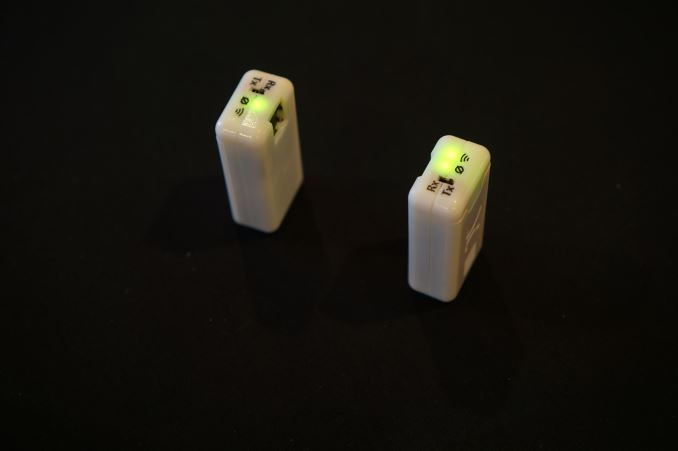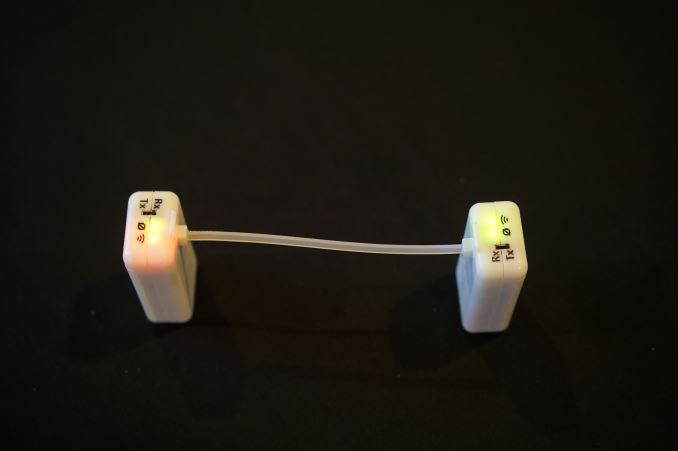Revisiting Keyssa: Commercial Availability, Products in Q1 2016
by Joshua Ho on January 7, 2016 7:00 AM EST- Posted in
- Mobile
- Trade Shows
- Keyssa
- CES 2016

While we talked about Keyssa at CES last year, details were rather sparse as the technology was still in the early stages of getting off the ground. However, this year Keyssa’s connector technology is now commercially available. Based upon discussions with those at Keyssa, products with this new technology could ship as early as Q1 2016.
For those that haven’t seen Keyssa in action before, it’s hard to really understand the potential of this technology. At a high level, it’s basically like NFC in the sense that this technology is very short range wireless with a range of roughly an inch or a few centimeters before the 60 GHz signal disappears completely. However, within that range you get 6 Gbps of bandwidth and relatively low power compared to something like 802.11ad/WiGig. Unlike 802.11ad WiFi, the connector and chip needed to enable this technology is almost absurdly tiny, as the chip is no more than a few millimeters squared. This is purely a physical layer technology, which means that at the operating system level a Keyssa connector can appear to be USB, DisplayPort, HDMI, SATA, PCIe, and pretty much any point to point digital connection protocol you can name today.
As a result, Keyssa has the potential to completely do away with physical data ports in devices. Probably the most obvious example of this would be 2-in-1 hybrid devices like the Surface Book, which in theory could completely do away with all of the wired connections that introduce additional engineering challenges when designing a device like the Surface Book.
Keyssa has also discussed the potential to replace flex cables internally in smartphones and other devices, which could reduce board area and/or z-height along with simplifying design and reducing cost as flex cables would no longer need to be laid out by hand.
This connector can also use simple plastic with certain shapes like tubes to introduce directionality and make wire-like connections over distance without the need for actual wires or proper connections.
Overall, Keyssa shows great potential and judging by the discussions I’ve had there’s a significant amount of interest from OEMs and ODMs for this technology, with hints that devices with this technology are already in development. It’s hard to say what the full potential of this technology is, but it’s definitely going to be interesting to see how this develops.













28 Comments
View All Comments
ddriver - Friday, January 8, 2016 - link
There are lot of scenarios where even such proximity will not be alarming or even noticed. Obviously, if you aim to jack someone's device, you will pick one of those scenarios rather than doing it in a conspicuous manner. And with high bandwidth, the proximity only needs to be momentary, at 6 gbit you can do a lot in just a moment.lorribot - Thursday, January 7, 2016 - link
Where would you put your SD card? For sure many don't have slots for those and there is always external/internet based storage but would require an amount of infrastructure or additional hardware to support. It will come down to cost and packaging, no point implementing it if you need more case room to support it and it costs more than what exists already.Murloc - Thursday, January 7, 2016 - link
sounds like a good solution to connect mobile devices to the TV without using the current hdmi over wifi stuff that just doesn't work.XZerg - Thursday, January 7, 2016 - link
what's the latency like?JoshHo - Thursday, January 7, 2016 - link
Latency is comparable to wired systems.jasonelmore - Thursday, January 7, 2016 - link
i dont see how this is a technology.. its more of a realization of the laws of physics and radio transmission.Hell someone could make a wireless (insert anything here) that works on the 10 mhz band, and the distance it could reach would be hundreds of miles. or a something like this that uses 60GHZ and only a short distance. its not really a breakthrough, we've known about RF physics for decades.
this is just radio frequency and the laws of nature, and a realization of the extremes of both ends. Anyone can do this, this company just made a prototype.
maximumGPU - Friday, January 8, 2016 - link
Because you know of some technologies that aren't a realization of the laws of physics?zodiacfml - Friday, January 8, 2016 - link
...and so is all the inventions and products we have today, good thing though this is not the size of a bedroom. You probably missed this part, "Unlike 802.11ad WiFi, the connector and chip needed to enable this technology is almost absurdly tiny, as the chip is no more than a few millimeters squared. "